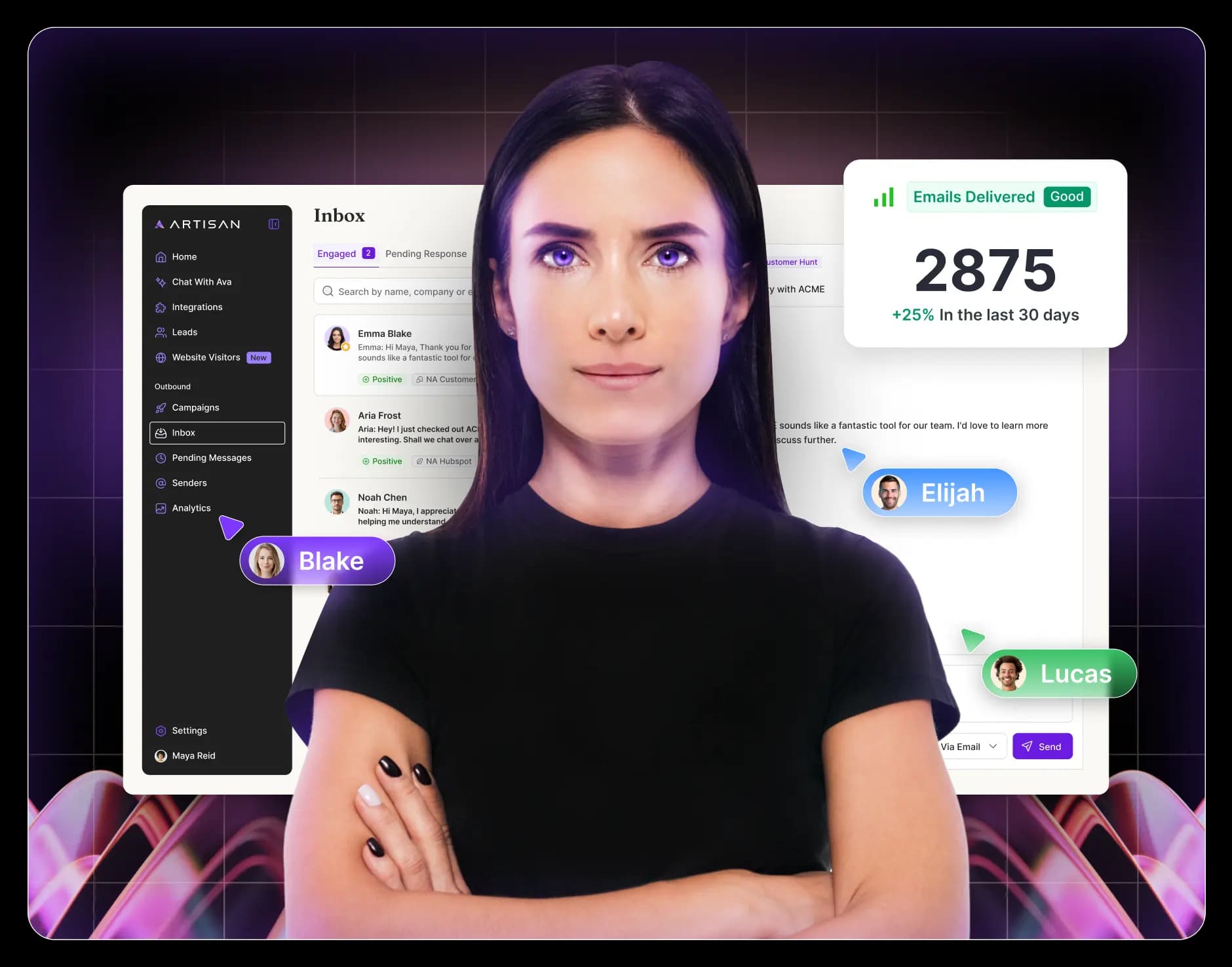What is B2B Outbound Sales? Techniques and Tools for Growth
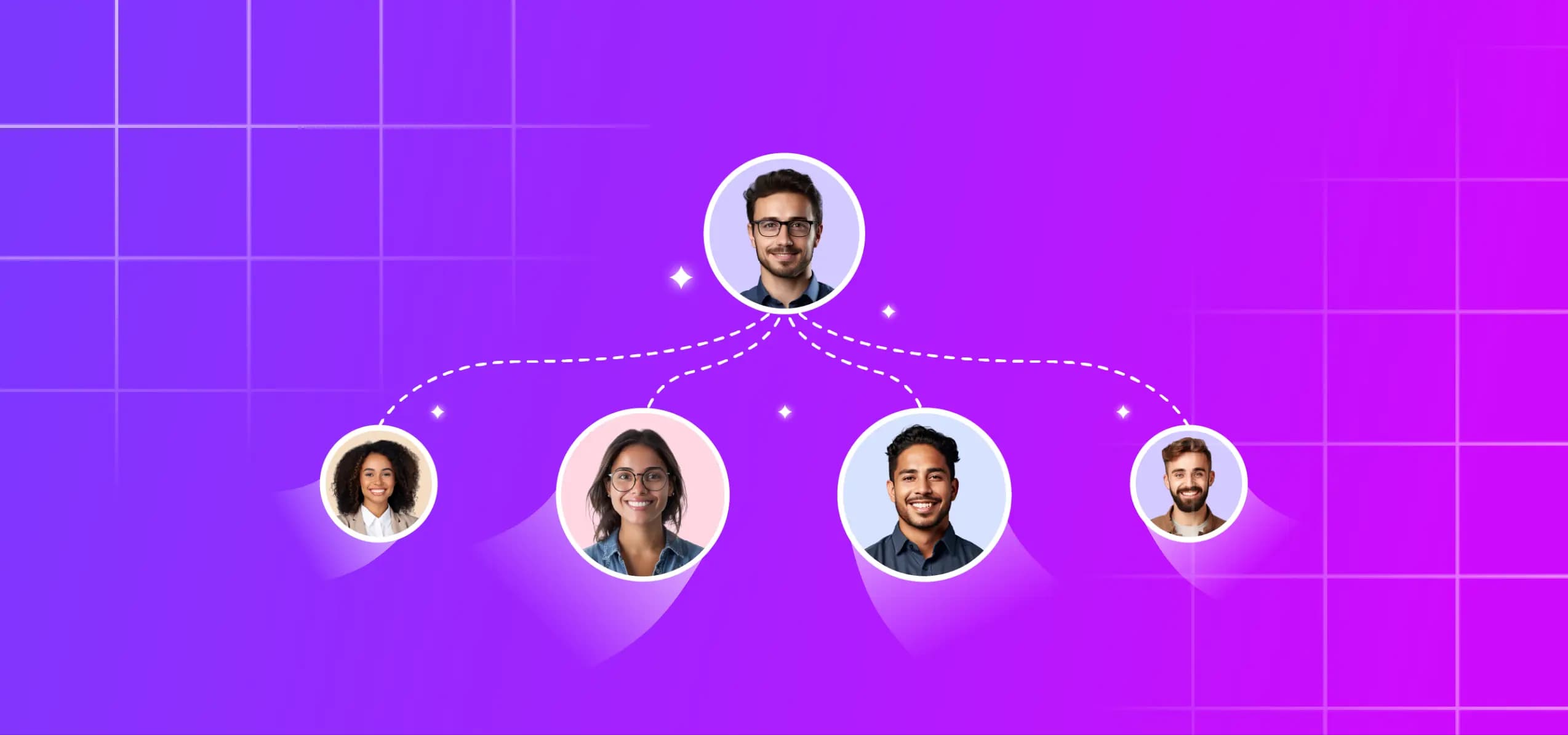
B2B companies get up to 90% of their leads from outbound sales. But let’s face it. Traditional B2B outbound sales techniques are time-consuming and resource-draining.
Between call screening, spam filters, and social media blocking, it’s no wonder why 52% of outbound marketers say their current outbound efforts are ineffective.
While inbound tactics can certainly enhance outbound efforts, they aren’t a standalone solution for guiding prospects through a complex sales journey. That’s partially because 71% of buyers actually prefer salespeople to reach out when they're looking for solutions.
It’s also because B2B outbound sales are fundamental to thriving B2B organizations. They enable companies to quickly target high-value prospects and key decision-makers and foster those connections until the deal is closed.
In this guide, we'll explore common outbound sales channels and the benefits of using outbound techniques. Plus, we’ll share some powerful tips to help you overcome your outbound hurdles and level up your B2B outbound sales strategies.
What is Outbound Sales?
So, what are outbound sales, and how do they differ from inbound sales?
Outbound sales is a proactive sales approach in which salespeople identify leads and initiate contact via email, cold calling, or direct messages. Outbound sales are all about finding and converting leads quickly, which is super valuable since, according to HubSpot, 74% of companies say converting leads in their CRM into paying customers is their top priority.
Inbound sales take a more passive approach. Despite its name, inbound sales is more of a marketing function focusing on attracting prospects via social media, content marketing, and search engine optimization. It encourages those prospects to engage with the company when they're ready.
If the differences are still a bit blurry, here’s a table to break down the key differences between the two.
Inbound | Outbound | |
Who makes the first move | The prospects | The sales rep |
Time to results | Gradual growth | Quick results |
Prospect targeting | Broad targeting | Precise targeting |
Costs | Higher upfront costs | Higher long-term costs |
Primary tactics | Social media posts SEO Blogs eBooks Webinars. | Cold emailing Cold calling DMs Direct mail Networking |
(Quick note about the costs: Outbound sales traditionally cost more due to the high price of talent and tools, but this is changing with the arrival of AI BDRs like Ava. Ava automates 80% of the outbound process, enabling you to increase efficiency while saving on long-term costs.)
Ultimately, the best B2B organizations incorporate a bit of both inbound and outbound to maximize their chances of converting and hitting KPIs.
Inbound sales build a strong pipeline of engaged prospects, while outbound sales ensure you don't miss any opportunities by targeting high-value accounts that can drive significant growth.
4 Common B2B Outbound Sales Channels for Lead Generation
B2B outbound sales are all about generating leads to pitch and close. Here are some of the most common B2B sales channels.
Cold Calling
Cold calling involves calling prospects who haven't expressed prior interest in your products or services. While many sales reps overlook making sales calls, they shouldn't because, according to recent data, 57% of C-Level and VP-Level buyers prefer to connect on the phone.
How to be successful: Success in cold calling depends on preparation, understanding the prospect's needs, and delivering a compelling value proposition. Generally, having a sales script and a clear goal for each call is important. For example, the goal of the first call may be pre-qualifying the prospect, understanding their key pain points, and taking notes about them in your CRM so that you're better prepared to close on the second or third call.
Cold Emails
Cold emails are unsolicited emails sent to potential leads to introduce your business. Generally, cold emails are sent in sequences—or multiple emails sent at specific, pre-determined intervals. However, they can also be one-off messages sent with the goal of initiating contact.
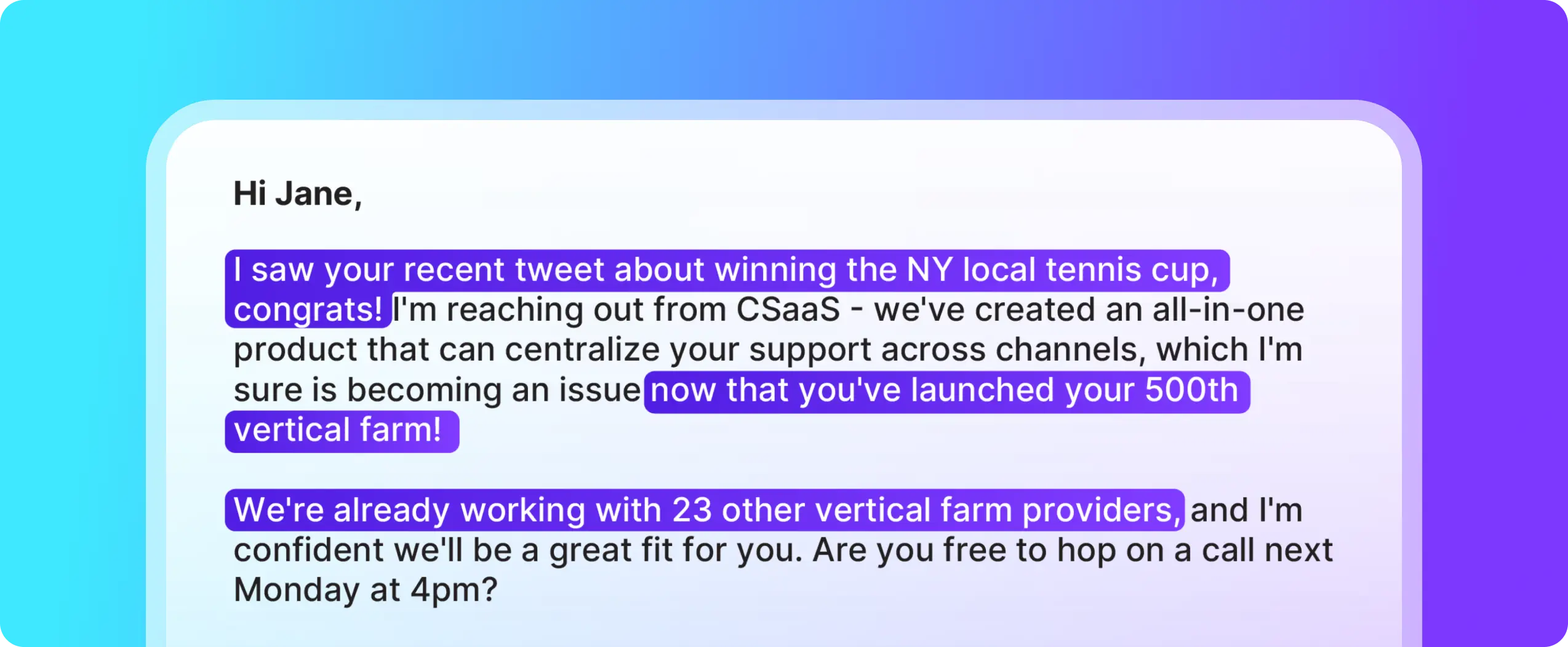
How to be successful: Effective cold emails are personalized, concise, and offer clear value. They should have a strong subject line since 69% of email recipients send emails to spam based only on their headline! They should also have a tailored message and a clear call to action.
Traditionally, cold emailing required an SDR to manually research prospects to craft personalized sales emails for each prospect. Now, AI SDRs can automate this entire process.
For example, Artisan’s SDR Ava uses the information you give her and independent research to automatically craft and send email sequences to prospects that match your ideal customer profile (ICP). She handles the research, personalization, emailing, and follow-up emails and adapts her responses to maximize results.
Want to automate your outbound emails? With our AI BDR Ava, you can launch your campaign to targeted prospects in minutes and avoid spam filters with mailbox health monitoring, placement tests, email warmup, and more.
Social Selling
Social selling is an approach that utilizes social media platforms to connect with and nurture potential leads. LinkedIn is particularly powerful for B2B social selling, enabling connections with decision-makers and industry leaders.
How to be successful: Every niche and platform has its own eccentricities, but, in general, sales professionals can build relationships with potential clients by sharing valuable content, engaging in conversations, and demonstrating expertise. Influencer marketing and partnerships may also be beneficial.
Networking Events & Webinars
Networking events, like industry conferences, trade shows, and local meetups, are excellent opportunities to meet potential customers face-to-face, build relationships, and gather insights.
Webinars allow you to reach a broad online audience, highlight your expertise, and establish thought leadership to a broad audience.
How to be successful: Preparation is key for in-person events. Reach out to prospects before events to schedule a time to chat. Bring your business cards, but more importantly, be ready to network. Remember to show genuine interest and try to connect with people. In other words, don't go straight for the pitch. Instead, focus on connecting and making positive impressions with potential clients.
If you're hosting a webinar, be sure to provide value to the attendees. If prospects feel like they were reeled into a webinar just to become a lead in your sales funnel, it'll leave a bad taste in their mouths. Think of it as an introduction to who your company is, and do your best to make sure it's a good first impression.
If you're attending a webinar, come with questions to ask and be a vocal and active contributor. It's much harder to connect and make an impression with online events, so plan how to make your mark.
B2B Outbound Sales Benefits
What makes B2B outbound sales particularly powerful? Here are some of the key benefits
Target the Right Audience
Outbound sales let you directly target your ideal audience. Instead of waiting for prospects to find you, you can reach out to those who fit your customer profile. Whether you buy leads, use a database, or scrape the web for prospects – with outbound sales, you can laser-focus on the types of companies that are the right fit for your offer.
This focused approach boosts the chances of conversion because you're actually targeting the right prospects. More importantly, though, it maximizes the sales teams' efforts. Outbound sales enable companies to zero in on their target audience, saving time and energy while boosting results.
Traditionally, to target the right audience, you had to generate or buy leads, but AI is flipping this process on its head. Now, with AI SDRs like Ava, you can simply share your customer personas with her, and she’ll search her database of over 300 million prospects to create a targeted outreach campaign on your behalf – no questionable lead companies or tedious web scraping required.
Personalized Outreach
Outbound sales enable personalized outreach and allow you to tailor your message to your prospect's specific needs – and there are few things more powerful than a highly targeted message.
Research has shown that companies that excel at personalization have 40% more revenue than their competitors who don't. Additionally, personalized messages have been proven to have a greater response rate than messages that don’t.
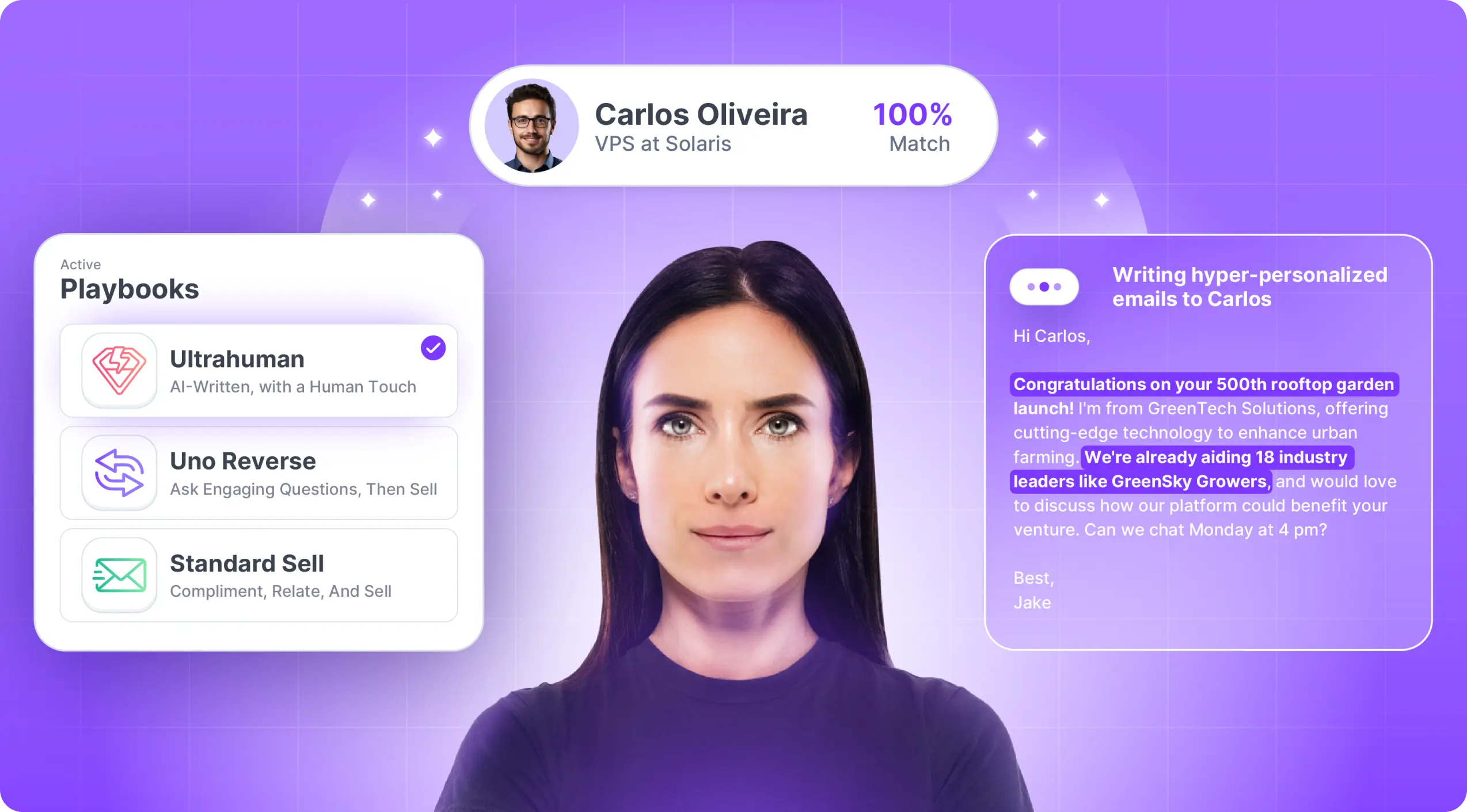
AI SDRs automatically personalize your emails. For example, Artisan’s AI SDR researches your prospects and can compliment them or ask them questions about their business based on the outreach playbook you select, virtually eliminating the hassle of conventional personalization.
Ava uses extensive personalization playbooks and scrapes the web and social media to find insights to craft highly personalized emails. Try Ava Now.
Shorten Sales Cycle
Outbound sales can accelerate the sales cycle. By initiating contact, you can move prospects through the sales funnel faster. You aren't waiting for them to make the first move (or take the next one).
With outbound sales, you can address objections, provide information, and guide prospects toward a purchase more efficiently than trying to drive them through the process with inbound techniques alone.
When you incorporate AI into the sales cycle, it can shorten it even more. AI SDRs learn from historical outreach performance and automatically adjust to improve results. For example, Artisan’s AI SDR has built-in self-optimization capabilities that adapt writing styles and optimize for positive outreach responses.
Boost Inbound Marketing
Inbound and outbound sales shouldn't be competing with one another. Instead, they should work in tandem, helping move prospects through the buyer journey.
While it's easy to see how inbound leads and strategies like content marketing and SEO can help outbound, it's not always as easy to see how outbound can also help inbound teams. However, direct interactions with prospects provide valuable insights that can improve your content and strategies. Outbound efforts also drive traffic to your inbound channels, which increases overall engagement and visibility.
6 Strategies for Successful B2B Outbound Sales
While every company's B2B outbound sales strategy will vary based on its specific team, goals, and needs, every successful strategy includes six basic steps.
1. B2B Outbound Prospecting
Prospecting is simply the process of finding and engaging with potential customers. However, when doing B2B outbound sales, you obviously can't just pick up the phone book and start dialing random numbers.
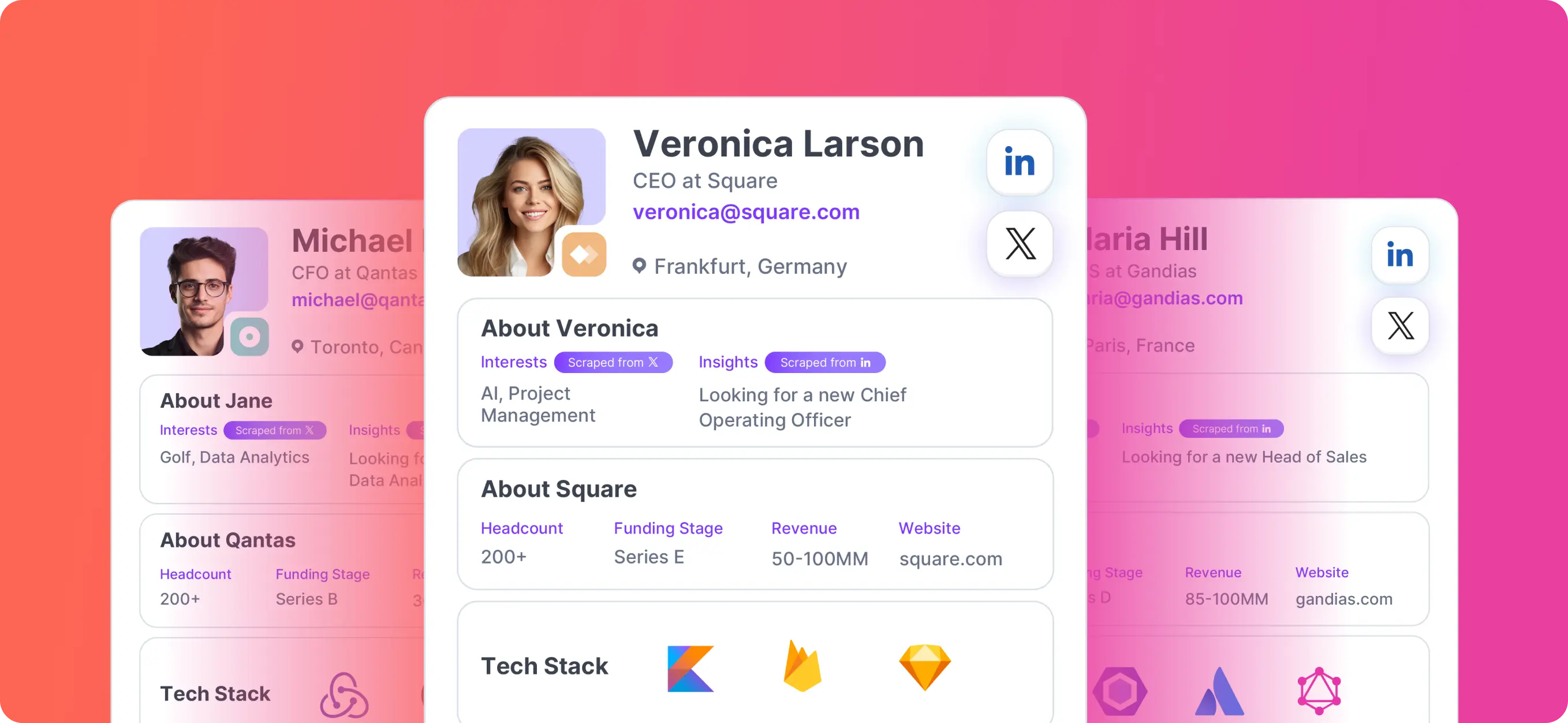
Instead, you have to get really good at sales prospecting, which starts by identifying your ideal customer profile (ICP). An ICP is a detailed description of the type of customer that would benefit the most from your product or service.
To identify your ICP, you can start by analyzing your current customers and identifying common characteristics among your best customers, considering factors like:
Industry: Which sectors do your best customers belong to?
Company Size: What is the employee count or revenue range of your ideal customers?
Location: Are your best customers concentrated in specific geographical areas?
Challenges: What common problems or pain points do your best customers face that your solution addresses?
Creating a well-defined ICP helps you focus your outbound sales efforts on prospects most likely to convert and makes it much easier to build a prospect list.
Once you know who your ICP is, you can use lead databases and tools like LinkedIn Sales Navigator or Artisan to build a prospect list. You can cut your prospecting time significantly with AI SDRs since they do the work for you. For example, with Artisan’s AI SDR Ava, all you have to do is tell her who your ICP is, and she finds them in Artisan's database of over 300 million B2B prospects.
Of course, not every prospect you find will be a perfect match. So, take some time to read and evaluate each prospect to ensure they're a good fit for your product or service before pouring tons of resources into reaching out.
2. Outreach Qualified Leads
Once you've got a strong list of potential customers, it's time to start the outreach process, and spoiler alert: generic messages won't cut it. To optimize your conversion rates, you need to personalize your outreach to address each person's specific needs and challenges.
To personalize, you'll have to do some basic research on the prospect's business to uncover contact information and other details like:
The company's industry
The prospect's name
The company name
Recent accolades
The pain points the company is experiencing
Then, you'll want to highlight all these things in your outreach.
When it comes to personalization, modern tools like AI SDRs can reduce the time and friction associated with personalization. For example, Artisan’s AI SDR uncovers all the contact information and details for you and crafts highly customized messages for each prospect so you can get more qualified prospects for substantially less effort.
It's also important to choose the right channel for reaching out since different channels can be more effective for certain industries and instances. For example, if your ICP is a technology startup, you might focus on LinkedIn since 82% of B2B marketers agree it's the best channel for B2B lead generation.
When planning your outreach strategy for your outbound sales team, you also need to develop a strategy for bypassing gatekeepers.
Include an image that includes the following definition; you may even include an image depicting gatekeeping, like a secretary on the phone, alongside the definition:
Gatekeepers: the receptionists or assistants who often screen communications for decision-makers.
Things like building rapport with the gatekeeper and using multiple channels (email, social media, calls) can maximize your chances of getting through.
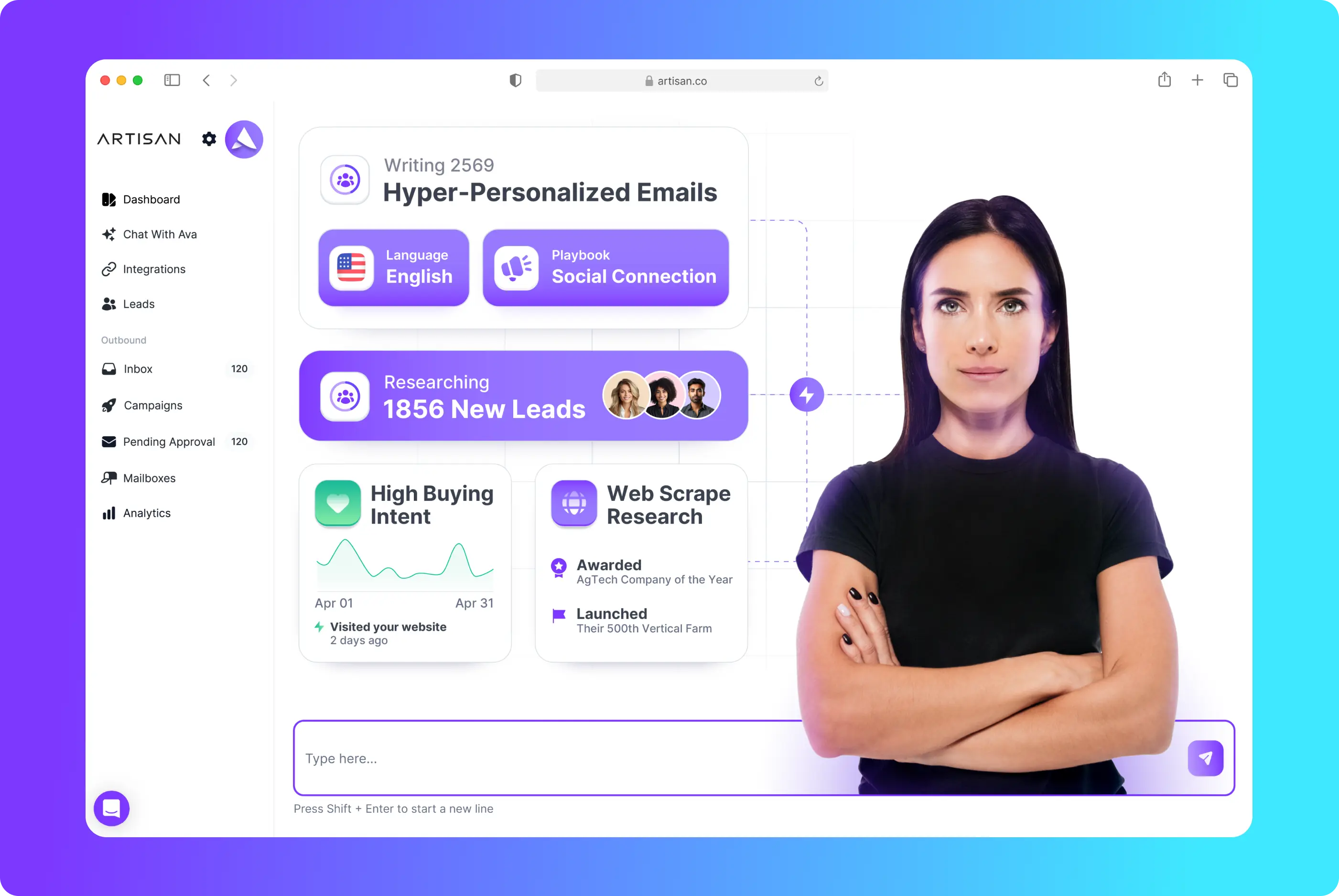
Ava is an AI BDR who automates 80% of the outbound sales process and can be set up with a 10-minute conversation. Ava creates the user's ICP, prospects with her database of over 270M contacts, does lead research, and crafts & sends highly bespoke email sequences. Want to give her a spin?
3. Qualification and Needs Assessment
Once you've engaged a prospect, the next step is to schedule a meeting to qualify the prospect and learn more about them.
For this first call, be upfront about what prospects should expect by establishing a clear agenda ahead of time. This can go a long way towards establishing your expertise and building trust.
Your primary goal should be to find the specific challenges and pain points the prospect is facing so you can ensure they're the right fit and better tailor a sales pitch for their unique needs and goals.
During the discovery call:
Ask open-ended questions to encourage the prospect to elaborate on their issues and actively listen to their answers.
Take notes and ask follow-up questions to gain deeper insights. Try to uncover as much about the decision-making process early on as possible.
Gently probe for budget information to ensure your solution aligns with their financial capabilities. Ask questions like: "What kind of budget do you have allocated for this project?" to get a sense of their financial constraints.
Identify the key decision-makers within the organization. This can be done by asking, "Who else should be involved in this conversation?" or "Who will be making the final decision?"
Include an image that turns the above bullets into a checklist titled “What To Do During a Discovery Call.” Only include the bolded text in the checklist
Keep in mind you shouldn't try to close them during this call. On average, it takes 18 calls to connect with a potential buyer and five additional follow-up calls to actually close the deal.
Taking the time to thoroughly qualify prospects and conducting a detailed needs assessment enables you to focus your efforts on leads with the largest potential to convert, saving time and resources while setting the stage for a successful sales engagement.
4. Value Proposition and Presentation
It may take several calls with several different stakeholders to get to this point, but once you get the opportunity to do a formal pitch – it's important to be prepared.
Start by preparing a personalized presentation highlighting how your product or service addresses the specific challenges and pain points discussed during the discovery call.
For the best results:
Use success stories and social proof, such as case studies and testimonials, to demonstrate the tangible benefits and results your solution has provided to similar companies.
Try to handle objections confidently and effectively. Be prepared to address common concerns and questions and provide clear, concise responses that reinforce the value of your offering.
Listen and respond to objections. Like in the discovery call, it's important to listen to the prospect's objections, understand their underlying concerns, and tailor your responses to alleviate those worries.
Use visuals, like slides, infographics, and videos, to make your points more compelling and easier to understand.
Encourage questions and discussions throughout the presentation to keep the prospect interested and to address any issues in real time.
By personalizing your pitch and confidently handling objections, you can ensure your presentation resonates with your prospects and moves them closer to a purchasing decision.
5. Negotiation and Closing the Deal
This is the stage in the B2B outbound sales process where your sales skills really come into play. There's usually a bit of persuasion, negotiation, and lots of persistence.
It's best to strive for win-win negotiations where both parties feel like they're gaining value. Make sure you clearly communicate the benefits of your solution and be prepared to discuss pricing, terms, and any potential adjustments.

It's important to be flexible during this phase, but it's equally important to stand firm on the value your product or service provides. Be sure to outline clear next steps to keep the momentum going. Your prospects should always know how to move forward with the deal.
After reaching an agreement, it may seem like your job is done, but consistent follow-up is crucial at this phase. It's not uncommon for deals to die in the pipeline – even after the prospect has agreed to move forward.
Regularly check in to address any lingering concerns and keep the prospect engaged. Use follow-up calls, emails, or meetings to reinforce the benefits of your solution and keep the deal moving forward.
6. Building Relationships and Account Management
After closing the deal, the focus shifts to building a strong, long-term relationship with the client, which starts with a smooth onboarding experience.
Once your client has signed the dotted line, be sure to guide them through the initial steps of using your product or service and point them to any other people they need to be aware of (i.e., account managers, customer support staff, etc.)
This stage may be more of an account manager or customer success function. Regardless, someone in your company needs to:
Schedule periodic check-ins to discuss the client's progress, address any issues, and gather feedback.
Identify opportunities to upsell or cross-sell additional products or services that can provide further value to the client.
Quickly resolve issues and be responsive to their questions to strengthen their loyalty and ensure a positive experience.
Happy clients are more likely to become repeat customers and refer your business to others. Who doesn't want that?
Optimize Your B2B Outbound Sales Strategy With AI
Outbound sales is an important function for almost every thriving B2B organization. It's an effective strategy for reaching prospects, getting quick results, and growing your organization.
However, it's not a walk in the park. Being good at B2B outbound sales requires you to be skilled at things like overcoming rejection, identifying the right decision-makers, crafting compelling pitches, and more.
It's a lot to balance. However, AI SDRs can address many of these challenges and streamline the pain points of outbound sales tremendously.
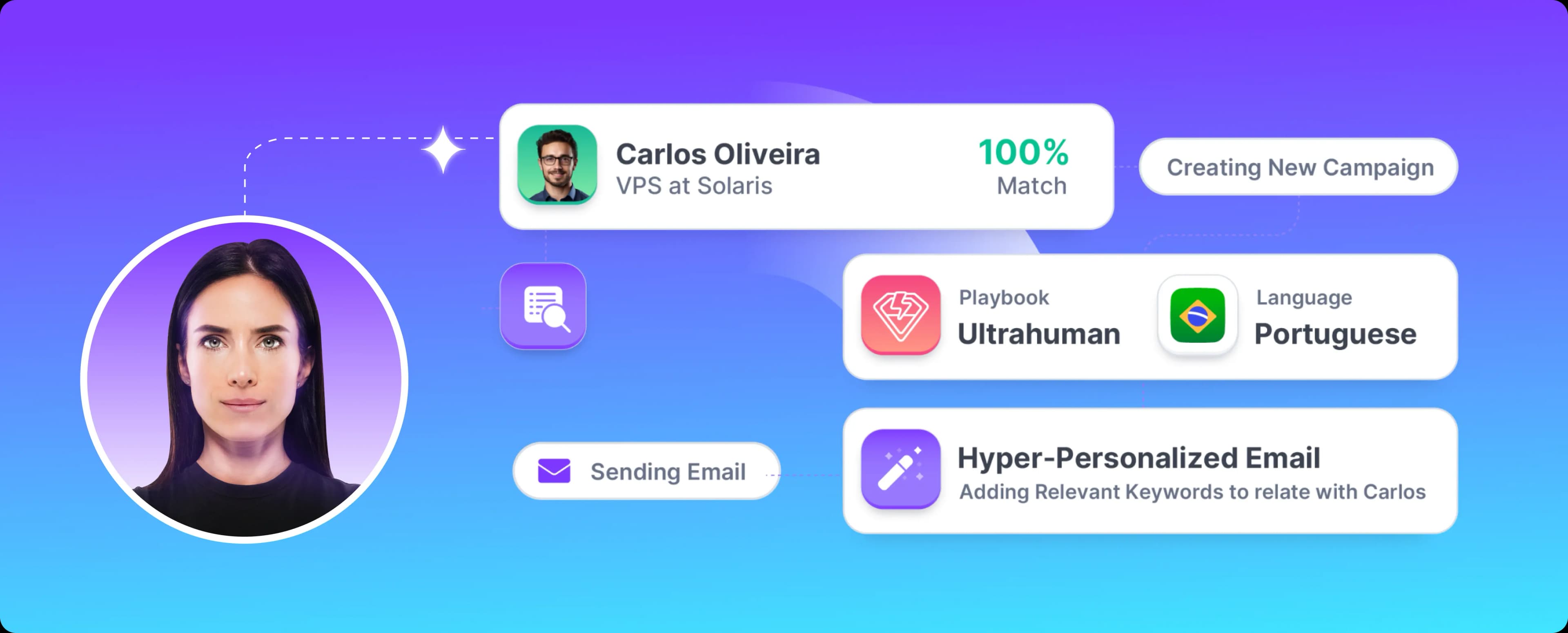
For example, Ava, the AI SDR by Artisan, can automate 80% of the sales process. In just 10 minutes, she learns about your ICP and product, creates an outbound campaign, selects leads from her database of over 270 million contacts, and starts prospecting.
She can send personalized sales outreach, write emails, optimize deliverability, and more, totally revolutionizing the outbound sales process of the past. With AI SDRs like Ava, companies can offload the time-consuming parts of sales, so human SDRs can focus more on making connections and closing deals.
Want to learn more about how AI SDRs can increase your outbound sales results? Hire Ava and see how easy B2B outbound sales can be with the right tools.
